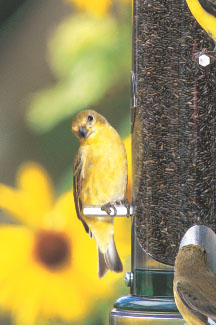Bird of the Month - Goldfinches

Performing a variety of aerial acrobatics, goldfinches seem destined more for the Big Top than the backyard. As they swoop from one invisible peak to another, you’re reminded of a certain circus counterpart who could also “fly through the air with the greatest of ease.” But as exciting as these daredevil flights are, they’re only part of what make a goldfinch worth watching.
Goldfinches live throughout the United States and southern Canada, a fact that makes attracting them to your backyard a bit easier. Though goldfinches carry the reputation of being finicky eaters, you’ll have no problem finding a suitable offering that will please their palate. Goldfinches love to eat fresh, dry Nyjer® (thistle).
Occasionally larger birds can intimidate and scare off potential goldfinch visitors. If there’s a problem with other small birds taking up space, some feeders can be turned upside down to accommodate agile goldfinches that have no problem eating upside down.
In early fall, the male goldfinches molt into duller winter colors that resemble the female's soft olive green and subdued yellow tones. And just when it seems as though winter will last forever, the male goldfinch forecasts spring’s arrival with the reappearance of its glamorous buttery yellow. Male or female, the goldfinch’s striking features are always pleasing to the eye and make any backyard distinctly more colorful.
Lesser Goldfinches are year-round residents of southern New Mexico, Arizona and south and west Texas. The back color of these birds vary geographically. Virtually all adult males in southern Texas are black-backed, and in New Mexico you will find a mix of green-backed and black-backed Lesser Goldfinches at your feeders. In the winter, you may also find American Goldfinches and Pine Siskins feeding alongside them.
The nests of Less Goldfinches can be found in cottonwoods and willows along rivers, though they nest in a variety of trees and bushes. The female selects the nest site, choosing a spot in a fork of branches 4 to 8 feet or higher off the ground.

